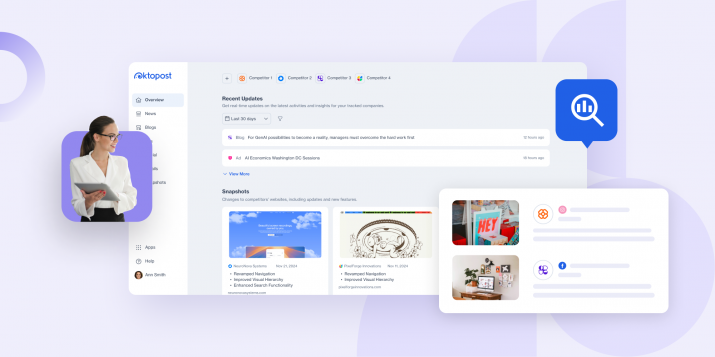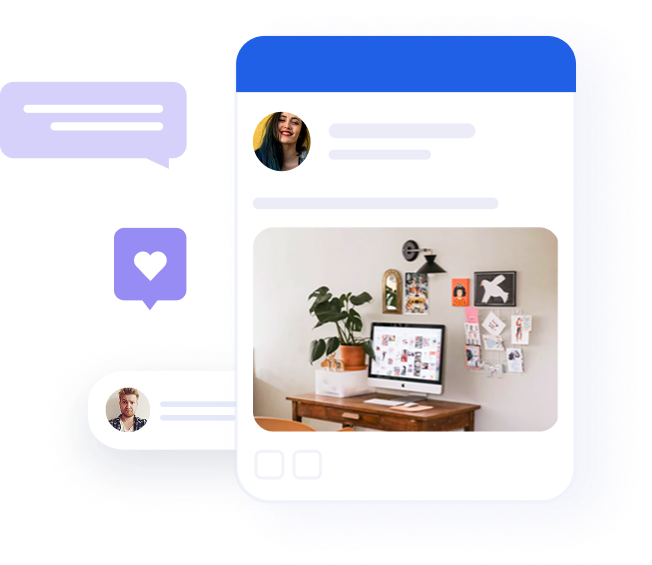
How social recruiting can find you the best talent
Table of contents
To ensure the continued success of your B2B company, you’ll need a system in place for recruiting stellar employees. And looking forward, a key component of such a system will probably be your social media presence.
More and more B2B companies smartly leverage their social presence to find highly-qualified job candidates. In an environment where the fight to win over active job seekers is fiercely competitive, and 75% of the employed workforce, consider themselves to be “passive” candidates who will only jump on the perfect opportunity, it’s even more important to be where potential employees can see you. That often means getting their attention through their LinkedIn and Twitter feeds, drawing them into social “talent communities” to create valuable interactions, and optimizing the hiring experience for everyone involved, from start to finish.
Here’s how B2B hiring managers and recruiters can leverage social platforms to find the best candidates for any open job.
Define ideal candidates and how you’ll get their attention
In B2B social media marketing, you reach customers by first figuring out who they are and what they want. Then you craft social content and build communities that appeal to their needs and tastes.
Smart B2B social recruiting is no different.
Just as you might use buyer personas and psychographics to identify the real-world and digital habits of prospective customers, a strong B2B hiring team will conduct talent segmentation in order to define the desired qualities of ideal candidates, and what those individuals do as they live their professional lives, both online and off.
Things to consider when segmenting your talent pool include current or most-recent job position, industry, education, and skills, as well as their online habits: the type of web content consumed and favorite social networks. Segmenting might also go beyond specified experience requirements for certain jobs, and be flexible enough to consider the right type of personality. For example, your software company might require 4-6 years of relevant experience for a new project manager, but a passive candidate who’s a highly praised data analyst in a tangential industry, and whose LinkedIn job history and endorsements suggest a propensity for determination and great people skills, might just be the person you need.
Here are some more specific ways you can begin to narrow down ideal talent:
- Experiment by categorizing current employees. For example, if you classify all employees by department, such as “Sales,” “Research and Development,” and “Customer Service,” you’ll better identify the ideal characteristics for each job type. Insights from department heads can give talent segments greater precision. You might also try segmenting by industry experience, specific skills, or personality characteristics—temperament can be a good indicator of how well a candidate will fit into your company’s unique culture.
- Consider the job candidates’ user experience. UX optimization isn’t always top-of-mind in recruitment, but perhaps it should be: the best possible user experience can only help you recruit top-tier professionals. According to Aberdeen, Best-in-Class companies (those in the highest tier of employee excellence, succession planning, and hiring manager satisfaction) are 55% more likely than all others to allow candidates to upload a LinkedIn or other social profile to apply for a job, speaking to the importance of making the job application process easy and intuitive. Your segmentation, if deep enough, will enable you to understand applicant expectations and “get inside their heads” more efficiently, especially for passive candidates who are keeping an eye open for well-catered job offerings.
- Strategize your recruitment “content marketing.” As part of the quest to find the best talent, you’ll have to craft content that appeals to the segment(s) you’ve defined for job candidates. The same content should do double duty in expressing your corporate culture, in the event that similarly-aligned candidates can identify with it.
- Finally, expand the hiring team to include more people. The hiring manager and recruiters alone shouldn’t be the entire hiring team. At least informally, most, if not all other internal stakeholders should be involved. Employees can be outstanding “brand ambassadors,” often enabling touchpoints that would be impossible otherwise. Best-in-Class businesses are 2.5 times more likely to integrate employee referral programs (ERPs) with their social media presence, highlighting how invaluable employees can be to the process. In implementing or refining your ERP, start thinking about incentivizing employees to suggest candidates they know, keeping them in the loop about open positions, and searching employee LinkedIn profiles for well-qualified candidates.
If you define ideal candidate characteristics beyond the on-paper job requirements, build a streamlined experience for job applicants, and expand your hiring team to include “everyone,” you’ll great footing to source the best talent, whether active or passive.
Candidate sourcing, vetting and hiring: An individualized, organic process
Once you’ve identified what the best candidates for each department will look like, it’s time to go after them.
A comprehensive social recruitment strategy should engage a mix of active and passive candidates at all times, but to get the most out of your efforts, think of short- and long-term company needs. Is there an upcoming vacancy that needs to be filled within a few weeks? If so—and you don’t have a highly-structured recruitment plan already in place—you might shift focus towards engaging active candidates. However, if revenues and company vision are expanding, with many potential hires happening in the next year, you’ll want to build your recruitment strategy now to attract the best-and-brightest “passive” minds steadily over time.
When seeking top-notch individuals to bring into the fold, especially when they’re not intentionally in the job market, consider the wisdom of the old adage: “If you build it, they will come.” While there’s no one-size-fits-all approach, having a recruitment framework in place is essential for successfully engaging passive candidates:
- Tweak your social profiles to attract potentials. By definition, your B2B social media marketing is focused on acquiring and nurturing business leads. But always be aware that potential job candidates might cross paths with your social profiles and see your thought-leadership content, especially if it’s of interest to accomplished industry professionals. Evaluate whether your social profiles feature a consistent tone and brand ethos, with content, suggestive of your company’s market position and corporate culture.
- Begin to build a social “talent community.” Talent communities, while no formal definition exists, can be thought of as interactive hubs where hiring managers, recruiters, and employees can talk with each other about company culture and job requirements, and engage with content they find relevant. Ideally, they’re fertile ground for just about any recruitment effort. While Facebook or Google+ are up to the task of hosting a talent community, LinkedIn’s offerings are unparalleled. You might choose to utilize LinkedIn Recruiter, which offers a complete solution for managing a talent pipeline on the network, and integrate with LinkedIn Groups, which feature a “Jobs” tab that lets employers target candidates with even greater precision.
- Have a protocol in place for adding potentials to your community. Job candidates should be able to enter your community through multiple touchpoints—be it via your regular and mobile-optimized websites, your social profiles, and in-person outreaches such as phone calls and networking events. Contact candidates who submit their resumes to you outside of your website, after vetting their applications, with an offer to join your community (even if you eventually turn them down for a specific position, they might be perfect for a future job). Also reach out to interested potentials who click through links in your Tweets and LinkedIn status updates, and use “Join” buttons on your website.
- Win over high-quality potentials through consistent, engaging and highly-targeted messaging.
If you’re constantly serving up content that keeps key individuals in the pipeline interested and involved, you’ll maximize the chances that some will become valuable employees. For example, interesting video content—showing off your physical office space, displaying friendly employee banter as staff are hard at work on an interesting project, or even a glowing customer testimonial that spotlights employee contributions—are sure to engage. Invite participants to webinars where digital face-to-face interactions can give both employer and candidate a sense of fitness and job-relevant knowledge. Every now and then, present calls-to-action for relevant job openings and phone or Skype calls with the core hiring team. You’ll want to integrate your social media management with your CRM to keep track of all touchpoints, both inside and outside your social media presence.
While passive candidates can be drawn into a well-marketed talent community and a highly customized user experience, you might take a more direct approach with active candidates. With 79% of job candidates generally, and 86% in the first 10 years of their careers, being likely to use social media in their job search, reaching them via social is a matter of placing job offers and opportunities within their easy reach. You can:
- Ask for recommendations and referrals from employees. An ERP that treats all staff as brand ambassadors from the start will facilitate this.
- Besides listings on job boards, you can advertise open positions on social profiles. The right social media management platform can help you post and track which outlets are the best for specific postings.
- Search employee social profiles directly for great candidates. Your employees’ LinkedIn profiles might be full of highly-qualified talent, just waiting for you to get in touch.
Finally, keep in mind that there isn’t one formula for successful recruitment. It all depends on the size, mission and current and future needs of your company.
Recommended for further reading
Review your social recruitment KPIs
After a few months of a fully-implemented social recruitment strategy, you’ll know whether it’s working or it needs work. There are many potential metrics to track from the beginning to the end of the hiring process, but broadly, there are a few KPIs specific to social recruitment that you’ll want to watch out for and optimize:
- Time and cost per hire. Simply put, on average, how long does it take, and how much does it cost, to turn a prospective employee into an actual one via social recruitment?
- Social engagements. Just as in your social media marketing efforts, you’ll want to keep an eye on whether your talent community posts are eliciting “likes,” shares, Tweets, and comments.
- Recruitment “conversion rate.” Be creative with the idea of “conversions” in the context of recruitment. Consider how many of your job “leads” are scoring interviews with recruiters, and how many are eventually becoming employees.
Keeping an eye on your social media analytics and other objective results will help you optimize your social recruitment for maximum efficiency. For example, if there’s a high cost per hire and relatively low engagement, you might revisit your content or hire a content creation agency for engagements that will better “convert” prospects to successful job applicants.
Social: A new trend in B2B recruitment
Social might have yet to catch steam among “traditional” recruitment sources such as job boards and referrals, but with the growing prominence of social media in B2B, it’s essential to lead in integrating your social presence with recruitment efforts to create an organic whole. By adding social depth to your talent acquisition protocol, bringing the most capable professionals into your company will only get easier.




